Virtual reality (VR) is a simulation created by a computer that uses photorealistic graphics to make the viewer feel as though they are in a different setting. A VR headset or gear is used to experience this setting. Video game play, heart surgery education, and sports performance can benefit from incorporating virtual reality (VR).
While this sounds like something from the far future, its history is much more ancient than you might assume. The origin of the invention can be traced back to the middle of the 1950s. The system and user interface have gradually grown due to subsequent software and hardware advancements.
This post will focus on trends in Virtual Reality in Australia.
Overview of Australian Virtual Reality Stats
1. Australia Has Over 130 VR Firms
- Data by TracXN
At the beginning of 2022, it was reported that there were 131 VR-related enterprises operating in Australia.
2. Fashion, Automobiles, and E-commerce Benefit Most From Vr
- Forbes
Forbes outlines the key sectors as those that stand to gain the most from virtual reality:
- Gaming
- Fashion
- E-commerce
- Automotive
- Hospitality
3. VR-Trained Doctors Performed Over 200% Better
- Data by Medical Futurist
Virtual reality (VR) training for surgeons resulted in about 230% improvement in performance. This was according to research published in Business Harvard Review.
4. VR in Education Boosts Test Scores by 20%
- Data by ClassVR
Virtual reality research in Australian academic institutions indicates a 20% improvement in student performance on standardised tests after its use in the classroom.
5. Virtual Reality Headsets Reduce Anxiety Among Patients
- Data by Medical Futurist
In 2022, more than 20% of Australians who used smartwatches and 3.2% of those who used VR gadgets did so to monitor their health remotely. Patients who participated in a survey about their experiences while using virtual reality headsets for medical purposes noted the following benefits of the technology:
- Improvements to the hospital simulation
- Feeling more comfortable
- Feeling less pain
- Having less anxiety
6. 2022’s Global Market Value Hit $21.83 Billion in 2022
- Data by Grand View Research
The global value of the virtual reality (VR) market reached $21.83 billion in 2022.
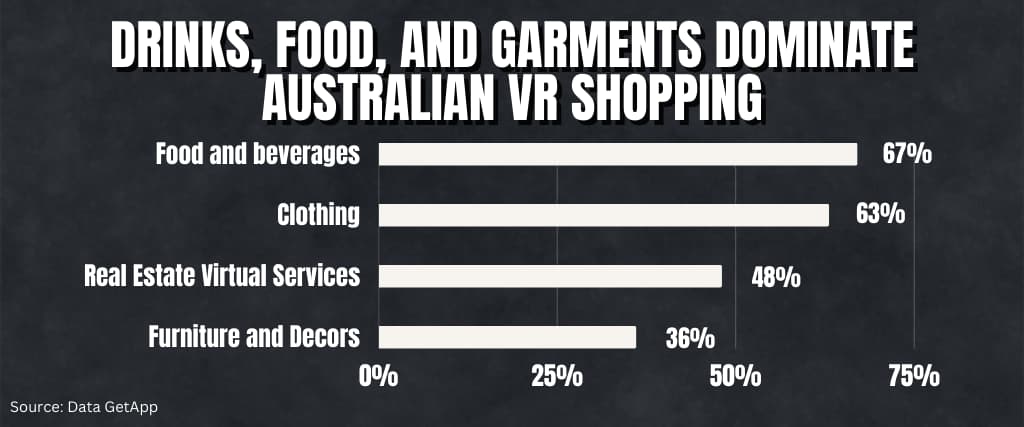
7. Drinks, Food, and Garments Dominate Australian VR Shopping
- Data by GetApp
Aussies use virtual reality shopping for the reasons listed below:
- Food and beverages (67%)
- Clothing (63%)
- Real estate virtual services (48%)
- Furniture and decors (36%)
Stats of the Virtual Reality Industry’s Market
8. The 2022 AR/VR Market Value Was $21.4 Billion
- Data by PR Newswire
The augmented reality (AR) market was valued at $15.3 billion by the end of 2022. On the other hand, experts estimated the value of VR to be 6.1 billion dollars over the same period.
9. Nearly 14 Million VR Devices Were Old Around the World in 2022
- Data by Yahoo!
In 2022, the global shipment of virtual reality (VR) devices reached around 13.48 million units.
10. AR/VR Is Expected to Increase by 18% By 2028
- Data by Grand View Research)
The augmented and virtual reality market is rising, and analysts predict it will expand by 18% per year.
11. 800,000 VR/AR Jobs Existed Globally in 2019
- Data by Statista
This year, the virtual and augmented reality sectors will employ approximately 820,000 individuals.
12. VR Spending Was Greatest among Consumers (53%)
- Data by IDC
Industry investment in virtual reality was most significant in 2022 in the following fields:
- Consumer (53%)
- Distribution & Services (15.8%)
- Manufacturing & Resources (13.8%)
- Public Sector (12.7%)
- Infrastructure (3.2%)
13. VR Can Boost E-commerce Conversions by Over 15%
- Data by Idya
There are many potential customers to reach out to since 9.1 million Australian homes were purchased from an online store in 2017. Virtual reality (VR) technology’s the potential to boost the online shopping exchange rate by 17%, as shown by data from 2022.
14. Engineering Firms Can Save 10% of Time With VR
- Data by Idya
The risk of building projects running late is one of the main issues confronting Australia’s construction sector. Using VR, engineers can reduce model-design time by 10% and building time by 7%.
15. VR Is Booming in Australia
- That by Mordor Intelligence
Markets for augmented and virtual reality in Australia, and the rest of the Asia Pacific region, are expected to develop rapidly in the coming years. The growth rates in Central America, South America, and Africa are much lower than those in Europe and North America.
16. Asia Pacific had 40% of the 2022 VR revenue
- Data by Grand View Research
China’s 40% revenue share in the Asia-Pacific region in 2022 was the highest of any nation.
VR User Stats Australia

17. VR Is Almost Equally Used by Men and Women
- Data GetApp
51% of men and 49% of females call Virtual Reality (VR) their primary form of entertainment in Australia.
18. VR Consumers Are 40% Millennial
- Data by GetApp
Recent surveys have shown that those between the ages of 26 and 35 make up 42% of Australia’s VR console user base.
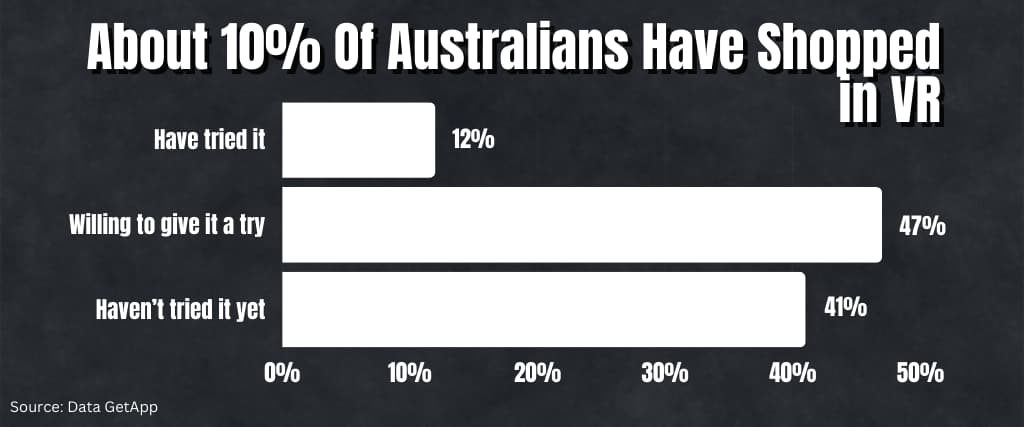
19. About 10% Of Australians Have Shopped in VR
- Data GetApp
Customers in Australia have few opportunities to experience virtual reality (VR), but they are interested in doing so in the future.
- Have tried it (12%)
- Willing to give it a try (47%)
- haven’t tried it yet (41%)
20. About 10% Of Australians Have Shopped in VR
- Data by GetApp
Over 40% of Australian VR users make between $50,000 and $100,000 yearly, while another 26% make more than $26,000.
21. Nearly 20% Of Australians Chose a Vacation Spot Online
- Data by Tourism Australia
Virtual reality (VR) is a helpful resource for picking vacation spots, and 19% of those individuals went to Australia.
Reality-Simulating Devices: Some Numbers
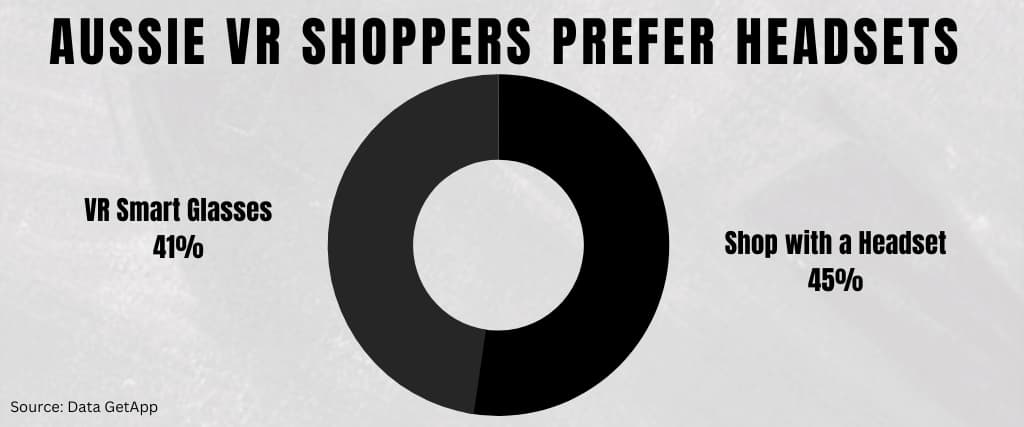
22. Aussie VR Shoppers Prefer Headsets
- Data GetApp
About half of Australians who have shopped using virtual reality (45%) have done so with a headset; another 41% have used VR smart glasses.
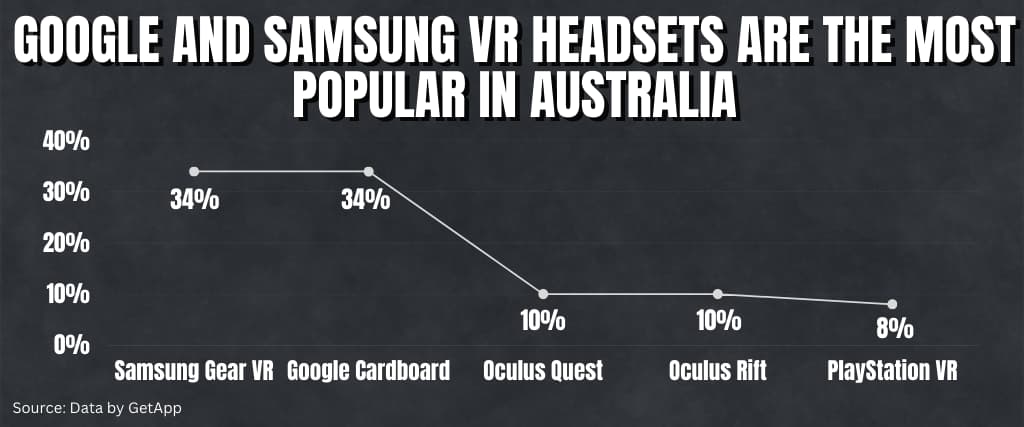
23. Google and Samsung VR Headsets Are the Most Popular in Australia
- Data by GetApp
The following are the VR headsets that are used the most frequently by Australians:
- Samsung Gear VR —34%
- Google Cardboard — 34%
- Oculus Quest — 10%
- Oculus Rift — 10%
- PlayStation VR — 8%
24. Vr Console Buyers Will Spend Up to Aud 300
- Data by GetApp
People who have already experienced virtual reality are prepared to pay up to A$300 for a headset, but others who haven’t would only try it for free if offered by the business.
25. Apple Launched a 2023 Headset
- Data by Road To VR
The price of Apple’s twin 8k display headgear, expected to be released later in 2023, is speculated to be over $3,000.
26. Facebook Acquired Oculus VR Goggles in 2014
- Data by The Farm 51
Fb purchased Oculus VR for a total price of $2 billion in March 2014.
Facebook Bought Oculus VR for $2 Billion in 2014.
27. AR/VR Will Engage 23 Million Individuals by 2030
- Data by Statista
By 2030, it is anticipated that the augmented and virtual reality industries will employ more than 23 million people.

28. Nearly Half of AU Shoppers Would Use VR Purchasing in the Future.
- Data by GetApp
Approximately 47% of Australian customers responded to a survey indicating that they would feel at ease using virtual reality (VR) when buying in the future.
29. Vr Gaming Will Earn $2.4 Billion by 2024
- Data by Idya
The increased popularity of virtual reality video games will lead to a rise in sales of up to $2.4 billion by 2024.
As of 2022, gamers have logged approximately 38 billion hours on Steam, a service that distributes video games.
30. AR/VR Might Boost GDP by $1.5 Trillion.
- That by PwC
The virtual reality sector alone (at $450.5 billion) can contribute $1.5 trillion to the world’s economy through augmented and virtual reality.
31. VR Will Have a Market Value of $69.60 billion in 2028
- Data by Grand View
According to forecasts by Grand Research, the VR business will be worth $69.60 billion worldwide by 2028.
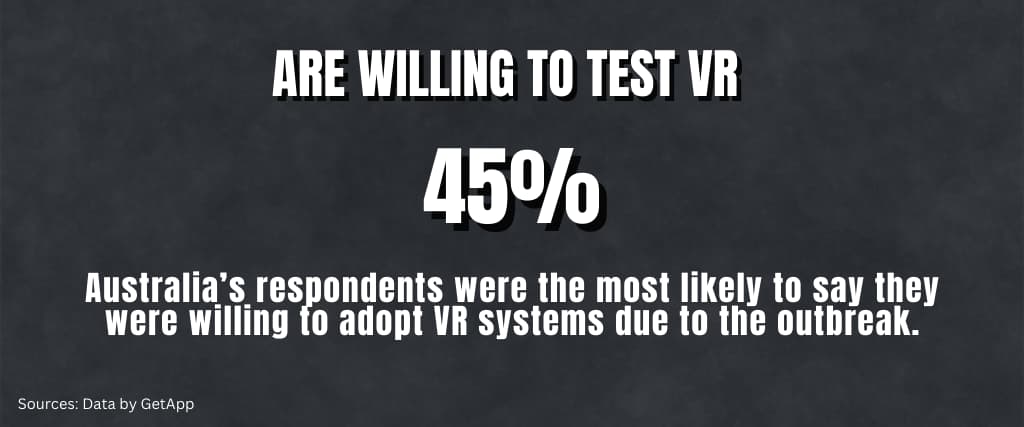
32. 45% Are Willing to Test VR
- Data by GetApp
Australia’s respondents were the most likely to say they were willing to adopt VR systems due to the outbreak.
Conclusion
This sense of the future is rare and helps explain why the virtual experience has become so popular. Since consumers’ feelings need to be stimulated, the rollout of VR in all significant industries is inevitable. Virtual reality statistics demonstrate the benefits of adopting this technology as soon as possible.